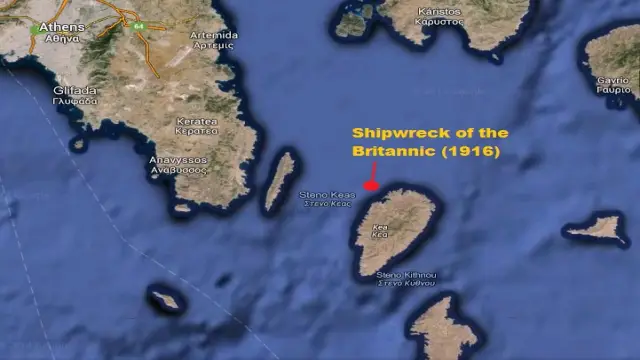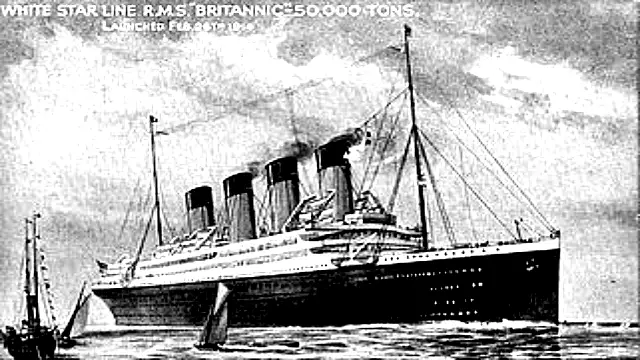Discover the Untold Story of the Britannic’s Final Voyage!
The HMHS Britannic was the third ship in the White Star Line’s Olympic class. While her fate may not be as famous as that of the Titanic, her story is filled with tragedy and heroism. Launched at the beginning of World War I, the Britannic was built with lessons learned from the Titanic disaster in mind. This article explores her journey, the events leading to her sinking, and the legacy she left behind.
A Safer Design
The Britannic was designed with enhanced safety features. Here are some key improvements:
- Wider Structure: The ship was wider than her sister ships.
- Double Hull: Vulnerable areas, like the boilers and engines, had a double hull for added protection.
- Reinforced Compartments: The watertight compartments were strengthened to prevent flooding.
- Extra Engine Power: The ship had more engine power to escape danger.
- Electronic Lifeboats: Unlike the Titanic, Britannic’s lifeboats could be lowered electronically, even if the ship was listing.
When launched, the Britannic boasted 48 lifeboats, each capable of carrying over 70 people—more than enough for her crew and passengers.
A Call to Service
The Britannic’s keel was laid in November 1911, just 13 months after the Olympic’s launch. However, history took a dramatic turn in 1915. After the Lusitania was torpedoed, the Britannic was requisitioned for national service with only four weeks’ notice.
The navy needed ships for the Gallipoli campaign, which resulted in heavy casualties. The Britannic was repainted white with a red cross and a green line, transforming her into a hospital ship. She completed five successful crossings to the Dardanelles.
The Fateful Day
On November 21, 1916, the Britannic was steaming through the Kea Channel with 673 crew members, 350 army medics, and 77 nurses on board. At 8:12 AM, a loud explosion rocked the ship.

Despite the safety measures, bad luck and human error played a role in the disaster. Passengers in the dining room quickly moved to their emergency posts, while others near the stern were unaware of the severity of the situation. Some crew members rushed to the deck, using the electronic system to lower lifeboats.
Captain Bartlett’s Decisions
Captain Bartlett, an experienced sailor, recognized the ship was listing. He ordered the watertight doors closed, believing the ship would remain afloat. However, he was unaware that some lifeboats had already been launched. The Britannic sent out distress calls, but the explosion had damaged the radio mast, preventing her from receiving help.
As the ship took on water, chaos ensued. The captain had no idea that portholes had been left open, leading to rapid flooding. Within just ten minutes, the Britannic was in dire straits, much like the Titanic had been after an hour.
The Struggle for Survival
Panic erupted on board. Stewards hesitated to lower the lifeboats, fearing the powerful propellers. As unrest grew, some lifeboats were launched prematurely, leading to tragic consequences. The assistant commander witnessed a lifeboat being sucked into the ship’s propellers.
Captain Bartlett made a brave decision to turn off the engines, prioritizing the safety of the remaining passengers. He then ordered an abandon ship. By 8:45 AM, the lifeboats on the high side were unusable due to the ship’s severe list.
Acts of Heroism
Despite the chaos, many crew members displayed remarkable courage. They launched smaller lifeboats and threw collapsible rafts and deckchairs into the water to assist those in need. The presence of army personnel helped maintain some order amid the turmoil.
At 9:00 AM, Captain Bartlett blew two long blasts of the whistle, signaling the final evacuation. He swam to a collapsible lifeboat, still in his pajamas. The captain’s last whistle formally released the remaining crew from their posts.
The Aftermath
Out of the 1,065 people on board, 30 lost their lives, many tragically struck by the ship’s propellers. At 9:07 AM, the Britannic sank completely, becoming the largest ship lost during World War I. To this day, she remains the biggest wreck on the sea floor.
A Legacy of Courage
The story of the HMHS Britannic is one of bravery and loss. While her fate may not be as well-known as that of the Titanic, her legacy lives on. The lessons learned from her tragic sinking continue to shape maritime safety standards today.
In conclusion, the Britannic’s journey serves as a reminder of the importance of safety at sea and the courage displayed by those who faced the unimaginable. The ship’s story is not just about its tragic end but also about the resilience and bravery of those on board.
Lessons Learned from the Britannic
The sinking of the Britannic led to significant changes in maritime safety regulations. Here are some key lessons that emerged from this tragedy:
- Improved Lifeboat Regulations: The Britannic disaster highlighted the need for sufficient lifeboats for all passengers and crew. This led to stricter regulations regarding lifeboat capacity and accessibility on ships.
- Enhanced Safety Training: The chaos during the evacuation underscored the importance of crew training in emergency situations. Today, crew members undergo rigorous training to prepare for various emergencies.
- Regular Safety Drills: The need for regular safety drills became evident. Ships now conduct frequent drills to ensure that both crew and passengers know how to respond in emergencies.
- Better Communication Systems: The failure of the radio system during the Britannic’s sinking prompted improvements in ship communication technology, ensuring that vessels can send and receive distress signals effectively.
The Wreck of the Britannic
Today, the wreck of the HMHS Britannic lies at the bottom of the Aegean Sea, near the Greek island of Kea. Discovered in 1975, the wreck has become a site of interest for divers and historians alike. Here are some fascinating facts about the wreck:
- Depth: The Britannic rests at a depth of about 400 feet (120 meters), making it a challenging dive site.
- Preservation: The cold, deep waters have helped preserve the wreck, allowing researchers to study its structure and the events leading to its sinking.
- Marine Life: The wreck has become an artificial reef, attracting various marine life, which adds to its allure for divers.
Remembering the Victims
The story of the Britannic is also a tribute to those who lost their lives during its sinking. Memorials and tributes have been established to honor the victims. These include:
- Memorial Services: Annual memorial services are held to remember the lives lost on that fateful day.
- Historical Exhibits: Museums and exhibitions often feature artifacts from the Britannic, providing insight into the ship’s history and the people who sailed on her.
- Documentaries and Films: The story of the Britannic has been the subject of various documentaries and films, helping to keep the memory of the ship and its passengers alive.
Conclusion
The HMHS Britannic’s story is a poignant reminder of the fragility of life and the unpredictability of fate. While her sinking was a tragedy, it also serves as a testament to human courage and resilience in the face of disaster. The lessons learned from her fate continue to influence maritime safety practices today, ensuring that future generations can sail with greater confidence and security.
As we reflect on the Britannic’s legacy, we honor the bravery of those who served on her and remember the lives lost in the depths of the Aegean Sea. The tale of the Britannic is not just a story of a ship; it is a story of humanity, courage, and the enduring spirit of those who faced the sea’s challenges head-on.
Explore the depths of history and remember the heroes of the HMHS Britannic!

